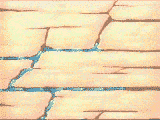

It is a common misconception that ground water is found in
underground rivers, like those that form limestone caverns. In
 fact, ground water is more like the water in a sponge, held
within the tiny pores of the surrounding
aquifer material. Much like the flow of water in a river, however, the
flow of ground water is subject to gravity and is almost always
in motion, flowing from areas of higher elevation to areas of
lower elevation. (In the case of ground water in confined
aquifers, it is pressure rather than gravity that makes water
fact, ground water is more like the water in a sponge, held
within the tiny pores of the surrounding
aquifer material. Much like the flow of water in a river, however, the
flow of ground water is subject to gravity and is almost always
in motion, flowing from areas of higher elevation to areas of
lower elevation. (In the case of ground water in confined
aquifers, it is pressure rather than gravity that makes water
 move. In this case, water flows from areas of high pressure to
areas of low pressure.) Just like what happens when a sponge soaked with water is tilted, gravity forces water to flow from one pore space or
fracture to another. The steeper the gradient or slope, the
faster the ground water will flow. It is important to note that
the rate of ground water flow, especially in confined systems, is
very slow compared to the flow of water on the surface. It is
typically in the range of several inches per year to several feet
per year.
move. In this case, water flows from areas of high pressure to
areas of low pressure.) Just like what happens when a sponge soaked with water is tilted, gravity forces water to flow from one pore space or
fracture to another. The steeper the gradient or slope, the
faster the ground water will flow. It is important to note that
the rate of ground water flow, especially in confined systems, is
very slow compared to the flow of water on the surface. It is
typically in the range of several inches per year to several feet
per year.
For water to move freely through a rock, the pores and/or fractures must be large enough and connected enough so that the friction from the water moving past the rock particle does not impede the flow. The degree of an aquifer's porosity and permeability is key to the movement of ground water through an aquifer.
Ground water can move through pores or
fractures.
| © Copyright |